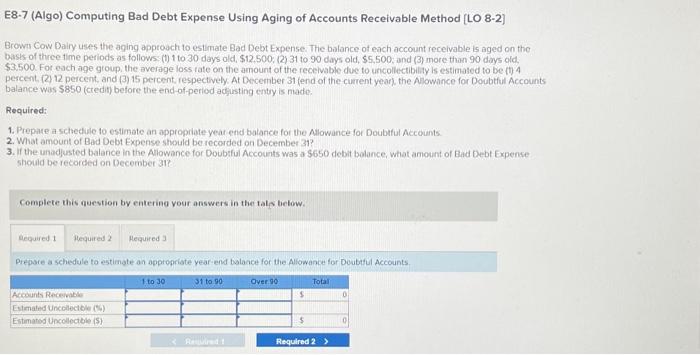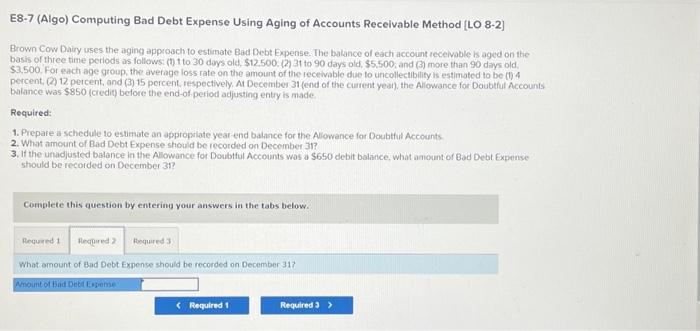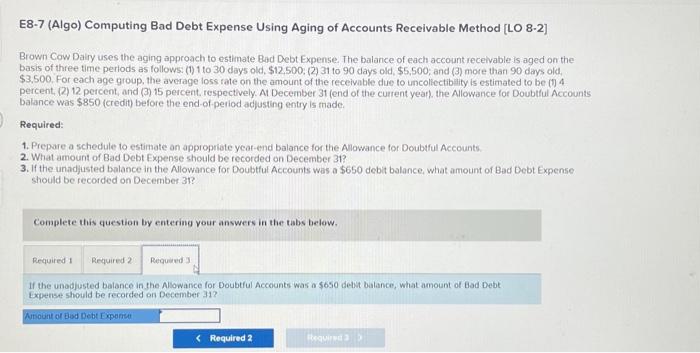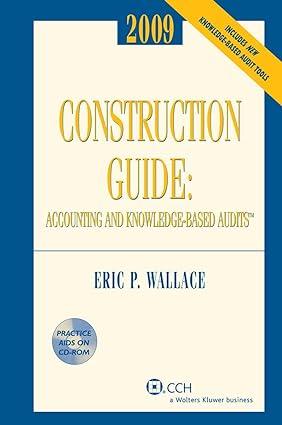E8-7 (Algo) Computing Bad Debt Expense Using Aging of Accounts Receivable Method [LO 8-2] Brown Cow Dairy uses the aging approach to estimate Bad Debt Expense. The balance of each account receivable is aged on the basts of three time periods as follows: (1) 1 to 30 days old, \$12,500; (2) 31 to 90 days old, \$5,500; and (3) more than 90 days old. \$3.500. For each age group, the average loss tate on the amount of the receivable duc to uncollectibility is estimated to be (t) 4 percent. (2) 12 percent, and (3) 15 percent, respectively. At December 31 (end of the current year) the Alowance for Doubtful Accounts balance was $850 (credit) before the end-of-period adjusting enty is made. Required: 1. Prepare a schedule to estimate an appropriate year end balance for the Alowance for Doubtful Accounts. 2. What amount of Bad Debt Expense should be recorded on December 31 ? 3. If the-unadjusted balance in the Alowance for Doubtful Accounts was a $650 debit bolance, what amount of Bad Debt Expense should be recorded on Decernber 3i? Complete this guestion by entering vour answers in the tals betow. Prepsie a schedule to estimate an appropriate year-end balance for the Allowance for Doubtul Accounts. E8-7 (Algo) Computing Bad Debt Expense Using Aging of Accounts Receivable Method [LO 8-2] Brown Cow Dairy uses the aging approach to estimate Bad Debt Expense. The balance of each account recelvable is aged on the basis of three time periods as follows: (1) 1 to 30 days old, \$12,500, (2) 31 to 90 days old, $5,500; and (3) more than 90 diys old, $3,500. For each age group, the average loss rate on the amount of the receivable due to uncollectibility is estimated to be (1) 4 percent, (2) 12 percent, and (3) 15 percent, respectively. A December 31 (end of the current yeal). the Alifowance for Doubtful Accounts balance was $850 (credit) before the end-of petiod adjusting entry is made Required: 1. Prepare a schedule to estimate an appropriate year-end balance for the Aliowance for Doubtful Accounts 2. What amount of Bad Debt Expense should be recorded on December I1? 3. If the unadjusted balance in the Allowance for Doublful Accounts was a $650 debit balance, what anount of Bad Debt Expense should be recorded on December ? Complete this question by entering your answers in the tabs below. What amount of Bad Debt Expense should be recorded on December 317 E8-7 (Algo) Computing Bad Debt Expense Using Aging of Accounts Receivable Method [LO 8-2] Brown Cow Dairy uses the aging approach to estimate Bad Debt Expense. The balance of each account receivable is aged on the basis of three time periods as follows: (1) 1 to 30 days old, $12,500, (2) 31 to 90 days old, $5,500; and (3) more than 90 days old. $3,500. For each age group, the average loss rate on the amount of the receivable due to uncollectibility is estimated to be (1) 4 percent, (2) 12 percent, and ( 3 ) 15 percent, respectively. At December 31 (end of the current year), the Allowance for Doubtful Accounts balance was $850 (credit) before the end-of period adjusting entry is made. Required: 1. Prepare a schedule to estimate an appropriate year-end balance for the Allowance for Doubtful Accounts: 2. What amount of Bad Debt Expense should be recorded on December 3 ? 3. If the unadjusted balance in the Allowance for Doubtful Accounts was a $650 debit balance, what amount of Bad Debt Expense should be recorded on December 3 ? Complete this question by entering vour answers in the tabs below. If the unodjusted balance in the Alowance for Doubtful Accounts Was a $650 delkt balance, what amount of Bad Debt Expense should be recorded on December 31









